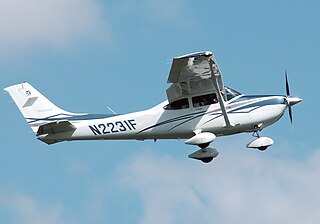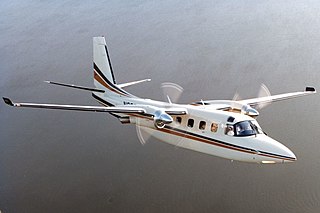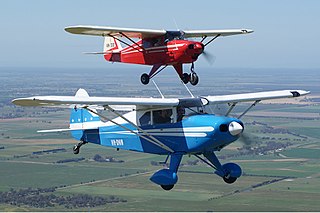
The Piper PA-28 Cherokee is a family of two-seat or four-seat light aircraft built by Piper Aircraft and designed for flight training, air taxi and personal use. The PA-28 family of aircraft comprises all-metal, unpressurized, single piston-engined airplanes with low-mounted wings and tricycle landing gear. They have a single door on the right side, which is entered by stepping on the wing.

The Piper PA-32 Cherokee Six is a series of single-engine, fixed landing gear, light aircraft manufactured in the United States by Piper Aircraft between 1965 and 2007.

The Cessna 182 Skylane is an American four-seat, single-engined light airplane built by Cessna of Wichita, Kansas. It has the option of adding two child seats in the baggage area.

The Piper PA-24 Comanche is an American single-engine, low-wing, all-metal monoplane of semimonocoque construction with tricycle retractable landing gear and four or six seats. The Comanche was designed and built by Piper Aircraft and first flew on May 24, 1956. Together with the PA-30 and PA-39 Twin Comanches, it made up the core of Piper's lineup until 1972, when the production lines for both aircraft were destroyed in the 1972 Lock Haven flood.

The Aero Commander 500 family is a series of light-twin piston-engined and turboprop aircraft originally built by the Aero Design and Engineering Company in the late 1940s, renamed the Aero Commander company in 1950, and later a division of Rockwell International in 1965. Final production occurred under the Gulfstream Aerospace name. The initial production version was the 200 mph, seven-seat Aero Commander 520. An improved version, the 500S, manufactured after 1967, is known as the Shrike Commander. Larger variants are known by numerous model names and designations, ranging up to the 330 mph, 11-seat Model 695B/Jetprop 1000B turboprop. As of recent, the Aerocommander is know as the Twin Commander.

The Beechcraft Model 50 Twin Bonanza is a small twin-engined aircraft designed by Beechcraft as an executive transport for the business market. It was developed to fill a gap in Beechcraft's product line between the single-engined Model 35 Bonanza and the larger Model 18. The Twin Bonanza is dissimilar to the Bonanza, being much larger and heavier and using more powerful engines, while in its earliest form having only half the passenger capacity of the Model 18.

The Piper PA-38-112 Tomahawk is a two-seat, fixed tricycle gear general aviation airplane, originally designed for flight training, touring and personal use.

The Piper PA-15 Vagabond and PA-17 Vagabond are both two-seat, high-wing, conventional gear light aircraft that were designed for personal use and for flight training and built by Piper Aircraft starting in 1948.

The PA-20 Pacer and PA-22 Tri-Pacer, Caribbean, and Colt are an American family of light strut-braced high-wing monoplane aircraft built by Piper Aircraft from 1949 to 1964.

The PA-25 Pawnee is an agricultural aircraft produced by Piper Aircraft between 1959 and 1981. It remains a widely used aircraft in agricultural spraying and is also used as a tow plane, or tug, for launching gliders or for towing banners. In 1988, the design rights and support responsibility were sold to Latino Americana de Aviación of Argentina.

The Piper PA-30 Twin Comanche is an American twin-engined cabin monoplane designed and built by Piper Aircraft. It was a twin-engined development of the PA-24 Comanche single-engined aircraft. A variant with counter-rotating propellers was designated the Piper PA-39 Twin Comanche C/R.

The Piper PA-34 Seneca is a twin-engined light aircraft, produced in the United States by Piper Aircraft. It has been in non-continuous production since 1971. The Seneca is primarily used for personal and business flying.

The Piper PA-44 Seminole is an American twin-engined light aircraft manufactured by Piper Aircraft.

The Piper PA-18 Super Cub is a two-seat, single-engine monoplane. Introduced in 1949 by Piper Aircraft, it was developed from the PA-11 Cub Special, and traces its lineage back through the J-3 Cub to the Taylor E-2 Cub of the 1930s. In close to 40 years of production, over 10,000 were built. Super Cubs are commonly found in roles such as bush flying, banner towing and glider towing.

The Cessna 210 Centurion is a six-seat, high-performance, retractable-gear, single-engined, high-wing general-aviation light aircraft. First flown in January 1957, it was produced by Cessna until 1986.

The Piper PA-31 Navajo is a family of twin-engined utility aircraft designed and built by Piper Aircraft for small cargo and feeder airlines, and as a corporate aircraft. Production ran from 1967 to 1984. It was license-built in a number of Latin American countries.

The Lycoming O-540 is a family of air-cooled six-cylinder, horizontally opposed fixed-wing aircraft and helicopter engines of 541.5 cubic inches (8,874 cc) displacement, manufactured by Lycoming Engines. The engine is a six-cylinder version of the four-cylinder Lycoming O-360.

The Piper Aerostar is an American twin-engined propeller-driven executive or light transport aircraft, designed by Ted R. Smith. It was originally built by Ted Smith Aircraft Company, which after 1978 became part of the Piper Aircraft Corporation.

The Maule M-7 is a family of single-engine light aircraft that has been manufactured in the United States since the mid-1980s.

The Piper PA-35 Pocono was an American 16/18 seat commuter airliner developed by Piper in the late 1960s. Only one aircraft was built and the design was not developed.





























